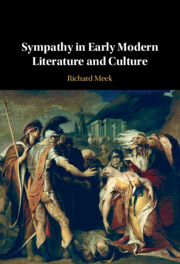Book contents
- Sympathy in Early Modern Literature and Culture
- Sympathy in Early Modern Literature and Culture
- Copyright page
- Contents
- Figures
- Acknowledgements
- Note on Texts
- Introduction
- Chapter 1 ‘A sympathy of affections’
- Chapter 2 ‘Compassion and mercie draw teares from the godlyfull often’
- Chapter 3 ‘Grief best is pleased with grief’s society’
- Chapter 4 ‘O, what a sympathy of woe is this’
- Chapter 5 ‘Soveraignes have a sympathie with subjects’
- Chapter 6 ‘As God loves Sympathy, God loves Symphony’
- Coda
- Bibliography
- Index
Chapter 3 - ‘Grief best is pleased with grief’s society’
Female Complaint and the Transmission of Sympathy
Published online by Cambridge University Press: 27 April 2023
- Sympathy in Early Modern Literature and Culture
- Sympathy in Early Modern Literature and Culture
- Copyright page
- Contents
- Figures
- Acknowledgements
- Note on Texts
- Introduction
- Chapter 1 ‘A sympathy of affections’
- Chapter 2 ‘Compassion and mercie draw teares from the godlyfull often’
- Chapter 3 ‘Grief best is pleased with grief’s society’
- Chapter 4 ‘O, what a sympathy of woe is this’
- Chapter 5 ‘Soveraignes have a sympathie with subjects’
- Chapter 6 ‘As God loves Sympathy, God loves Symphony’
- Coda
- Bibliography
- Index
Summary
This chapter considers the first appearances in print of the word sympathize (1594) and argues that complaint poetry was an especially fertile genre in which ideas of emotional imitation and transmission were themselves imitated and transmitted. The chapter examines the poetics of feeling in Samuel Daniel’s The Complaint of Rosamond (1592). It goes on to discuss Shakespeare’s The Rape of Lucrece (1594), and focuses on Lucrece’s emotional encounter with her maid, who, ‘enforced by sympathy’, begins to weep herself. The chapter then examines how this sympathetic encounter was appropriated and reworked by several writers in the years that followed, including John Trussell’s The First Rape of Faire Hellen (1595) and Samuel Nicholson’s Acolastus (1600). This process of textual transmission and dissemination is also at work in the various poetic miscellanies that appeared at the turn of the seventeenth century, including Bel-vedére; or, The Garden of the muses (1600) and Englands Parnassus (1600), both of which include extracts from several of the poems discussed in this chapter.
Keywords
- Type
- Chapter
- Information
- Sympathy in Early Modern Literature and Culture , pp. 103 - 138Publisher: Cambridge University PressPrint publication year: 2023



